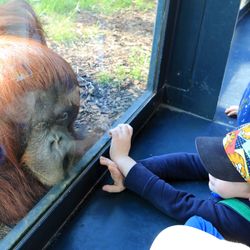When pondering the question, “Are orangutans friendly to humans?” one must delve into the nuanced dimensions of their behavior and the cultural relativism that surrounds the human-animal relationship. The playful nature of orangutans often fosters a perception of friendliness, yet a more profound exploration into their societal structures, communication methods, and emotional depth reveals a more complex interplay. To understand their actions and interactions, we must navigate through their ecological niche, social constructs, and the anthropocentric lens through which we view them.
Orangutans, predominantly found in the rainforests of Borneo and Sumatra, exhibit significant intelligence, often engaging in behaviors that suggest a form of social awareness. While they are primarily solitary creatures compared to other great apes, they do have intricate social networks. The distinction between solitary and social species can often cloud our interpretation of friendliness; after all, just because an animal prefers solitude does not imply unfriendliness. In fact, solitary species can demonstrate depth in their interpersonal interactions when they do engage with others. This ongoing debate invites us to reconsider our preconceived notions of what constitutes friendliness in the animal kingdom.
From a cultural relativism perspective, it is crucial to acknowledge that human definitions of friendliness may not align with those exhibited by orangutans. In human societies, friendliness often translates to open social interaction, overt communication, and physical proximity. However, an orangutan’s reticence to approach or frequent human contact might signify a different form of intelligence that prioritizes caution and observation. The orangutan’s innate curiosity is manifest in their interactions; they often display a propensity for play—a key indicator of cognitive engagement. This creates a paradox: humans may interpret playful gestures as friendliness, yet these behaviors could merely reflect an opportunistic engagement.
Furthermore, the intricate communication methods of orangutans showcase their emotional breadth and capacity for social nuance. They utilize a complex array of vocalizations, gestures, and facial expressions to convey their needs and intentions. Researchers have documented instances where orangutans will mimic human behavior or engage with children, stirring speculation about their capacity for empathy. Nevertheless, one must question whether such interactions are genuinely friendly or pragmatic adaptations to situational contexts. Cultural relativism emphasizes that interpreting these behaviors purely through a human-centric lens may lead to misjudgments about their intentions and emotions.
Orangutans exhibit what can be termed ‘conditional engagement’ with humans. Situations often arise where orangutans feel a degree of safety and can exhibit seemingly friendly behaviors. However, in the presence of perceived threats, their demeanor shifts dramatically. This adaptability poses a challenge to our understanding of their social behavior. Are these shifts indicative of friendship, or do they reveal a more intricate strategy for survival? Evaluating this behavior through the lens of cultural relativism helps illuminate that friendliness may not be an absolute trait but a spectrum influenced by context.
Moreover, the impact of human encroachment on their natural habitat cannot be underestimated in this discourse. Deforestation, poaching, and climate change have altered the orangutans’ experience of humanity. In situations where orangutans have become habituated to human presence due to tourism initiatives or rehabilitation efforts, their responses can mimic that of domesticated animals, perhaps leading humans to misinterpret these responses as inherent friendliness. This convolution speaks to the necessity for responsible engagement with wildlife, recognizing the impact of human activity on animal behavior. The very question of whether orangutans are friendly can evoke profound ethical considerations; it compels us to critically assess our role as stewards of the environment and our responsibilities toward these magnificent beings.
In engaging with orangutans, the concept of cultural relativism also prompts a reconsideration of anthropomorphic tendencies. Assigning human emotions and intentions to orangutan behavior simplifies their complex existence. This misrepresentation can lead to detrimental outcomes, including unrealistic expectations of friendliness and affection in human-animal interactions. Understanding orangutans requires a commitment to viewing their experiences through the framework of their ecological and social realities rather than through an anthropocentric lens that often dominates discourse.
Ultimately, the relationship between humans and orangutans underscores the necessity for a respectful distance. As we study their behavior, the challenge remains to appreciate their profound intelligence and emotional depth while acknowledging their autonomy. Rather than labeling them as friendly or unfriendly, we must celebrate the diversity of their behaviors, recognizing that communication and interaction vary across species. Acknowledging the spectrum of engagement invites a richer understanding of orangutans, anchored in respect for their autonomy and the recognition of their intrinsic value beyond human definitions.
In conclusion, the inquiry of whether orangutans are friendly to humans is intricate and laden with complexities that extend beyond mere observations of behavior. Through cultural relativism, we are called to explore, critique, and ultimately embrace the multifaceted dimensions of what it means to coexist with them in their natural environment. The narrative becomes less about labeling and more about understanding the shared tapestry of life that connects all beings on this planet.
